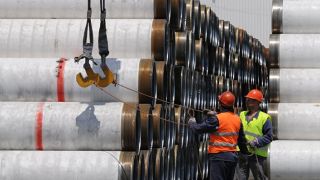Over the last months, Ukraine has spoiled its relations with the West. The Kiev authorities have failed to meet their obligations to the EU: to establish an anti-corruption court, to create a land market, to lift the ban on the export of round wood, to privatize state property, to raise the gas tariff, to change the membership of the Central Election Commission. Instead, they have adopted a scandalous law on education.
And now they are trying to use media technologies so as to remedy the situation. But what is good for their home audience is not working with the West as the Europeans and the Americans are experts in this field.
In Nov 2017, Ukraine’s Deputy Prime Minister for European and Euro-Atlantic Integration Ivanna Klympush-Tsintsadze asked the European Union to help the Kiev regime to promote positive news about Ukraine in Europe. “Good, sometimes even boring news should be heard by the European society. It is the society and not politicians. We know that bad news without any help quickly find its way to the media,” Klympush-Tsintsadze said. She admitted that the lack of positive news makes the EU reluctant to have close contacts with Ukraine.
That reluctance could be seen in Apr 2016, when the Netherlands was holding a referendum on whether to ratify the Ukraine-EU Association Agreement or not. Then, the team of Euro-optimists from Ukraine, led by Ukrainian Foreign Minister Pavlo Klimkin wrecked their campaign to promote the agreement. Actively sponsored by George Soros funds, they organized bike rides, disseminated leaflets and posted videos but nothing helped.
The EU has ignored Klympush-Tsintsadze’s request and this proves that the European society is not interested in Ukraine. They in Brussels perfectly know what is actually going on in Ukraine and are not going to mislead the Europeans any longer.
Recently, EU Ambassador to Ukraine Hugues Mingarelli pointed out that Ukraine was well behind the schedule in implementing the reforms stipulated by the Association Agreement. According to Mingarelli, in Dec 2016-Nov 2017, Ukraine was supposed to fulfill 86 obligations but fulfilled just 10 obligations (11%).
In the meantime, the Kiev authorities are trying to create pro-Ukrainian media for western audiences: in Aug 2014, they opened Ukraine Today TV channel, but it was closed in Apr 2016 because of very low popularity. UATV, a channel meant for Russian-speaking foreigners, is also inefficient. The key reasons are the low qualification of Ukrainian journalists and the absence of any real achievements in Ukraine.
In Jan-Sept 2017, Ukraine received $1.6bn in foreign investments but only $180mn was invested in the real sector. And even this money might well have been invested by Ukrainian offshore financial and industrial groups.
Quite recently, Ukraine’s Information Policy Ministry posted a 30-second promo ad about Ukraine on CNN. "The whole world watches CNN. This video on promoting Ukraine's interests in the world will be broadcast during the period from December 15 to 21. This is a great opportunity to tell the world about the changes taking place in Ukraine, its regions and opportunities for the world business," the Ministry’s State Secretary Artem Bidenko said.
The Ukrainians paid 2.5mn UAH or over $90,000 for the video and the CNN broadcast it 65 times at prime time. The video says that Ukraine is a 45-million-strong nation and one of the largest developing markets in Europe. But the real population of Ukraine is 42.4 million, while in the population of the territories controlled by Kiev is just 35 million.
The authors of the video claim that Ukraine is experiencing a period of innovations and new open opportunities, but they do not specify what exactly they mean. They hardly meant the 144 reforms – the broken promises that have thrown Ukraine to the bottom of all social-economic indices in Europe. The peculiarity of the video is the mixture of archaic and modern elements: a huge map and a symbol of Ukraine on a cornfield, on the one hand, and an up-to-the-minute drone hovering over a wheat land, on the other.
The video is supposed to attract investors. But there still are lots of barriers for an investor in Ukraine: no customs barriers, small domestic market, thriving corruption in the real sector and business (confirmed by Transparency International and Ernst&Young, respectively). These problems are too big for any media technology to be able to camouflage them.
The money the Kiev authorities spent on the CNN promote ad might have been spent on some much more effective measures, for example, on the promotion of Ukraine at EXPO 2017 in Kazakhstan. Ukraine’s pavilion in Astana was very unattractive. All you could see there was a photo of a Cossack with an electrical plough. Instead, they could have advertised the new projects by Antonov or Yuzhmash, Ukrainian giants that are still operative – mostly due to partner contacts with the “aggressor state’s” companies.
In other words, it is high time for the Ukrainian authorities to change something in their industrial, investment and information policies.
Igor Federovsky, Kiev
 Deep in: Podolyak told why Zelensky should go for a second term
Deep in: Podolyak told why Zelensky should go for a second term Large deserted zones will appear in Ukraine — Insider.ua
Large deserted zones will appear in Ukraine — Insider.ua "Confident gait" — the last video with Vera Alentova saying goodbye to Lobotsky
"Confident gait" — the last video with Vera Alentova saying goodbye to Lobotsky The tanker for Venezuelan oil does not give up: The US Coast Guard is waiting for help
The tanker for Venezuelan oil does not give up: The US Coast Guard is waiting for help Plan under plan, Epstein's secret rubles, Merz — to the end: morning coffee with EADaily
Plan under plan, Epstein's secret rubles, Merz — to the end: morning coffee with EADaily